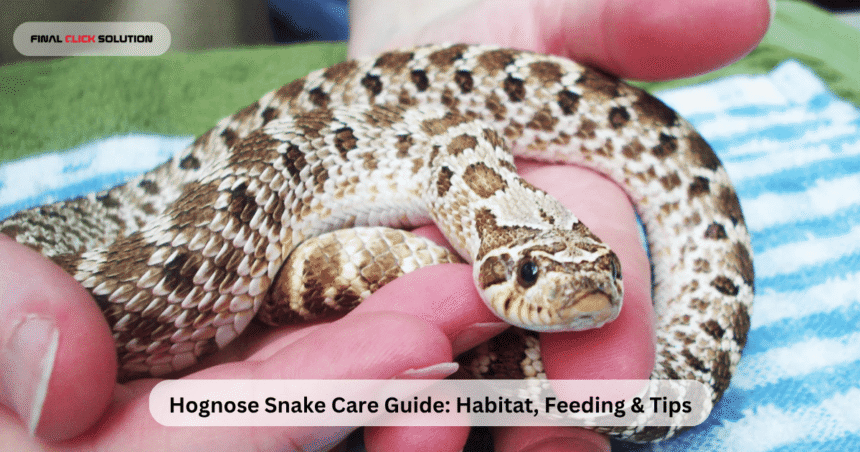Owning a Hognose snake can be one of the most rewarding experiences for reptile enthusiasts. Known for their docile nature, fascinating behaviors, and unique appearance, Hognose snakes have become a favorite among beginner and experienced keepers alike. This guide will walk you through everything you need to know about caring for your Hognose snake — from diet and habitat setup to health, handling, and enrichment.
1. Understanding the Hognose Snake
Scientific Name: Heterodon nasicus
Average Lifespan: 15–20 years
Average Size: Around 2 feet (females larger than males)
Hognose snakes originate from North America and are known for the distinctive upturned scale on the end of their nose, which they use to dig and burrow in sandy soils. Their striking color patterns, easy temperament, and relatively small size make them excellent pets for first-time snake owners.
What makes them truly unique is their behavior. When threatened, Hognose snakes are famous for their dramatic defense displays. They may flatten their necks like a cobra, hiss loudly, or even roll over and play dead. Despite these theatrics, they are rarely aggressive and are considered harmless to humans.
2. Handling Your Hognose Snake Safely
Handling your snake properly builds trust and reduces stress for both you and your pet. Although Hognoses are not typically defensive, they can become startled if approached incorrectly.
Tips for Safe Handling
- Never surprise your snake: Always ensure it is awake before you handle it. Gently touch its side to let it know you’re there.
- Approach from the side, not above: Snakes view movements from above as a predator’s attack, which can cause defensive reactions.
- Support the body: Hold your Hognose gently but securely, supporting its midsection and allowing it to move freely through your hands.
- Avoid handling after feeding: Wait at least 24–36 hours after feeding before picking up your snake to prevent regurgitation.
- Stay calm and confident: Sudden jerky movements can alarm your snake and cause it to hiss or puff up defensively.
Though Hognoses are mildly venomous, their venom poses no threat to humans unless you have an allergy. Their bites are rare and typically cause no pain or swelling — most keepers agree that the fear of being bitten is far worse than the bite itself.
3. Feeding and Diet
Hognose snakes are carnivores and eat a variety of small prey in the wild such as rodents, frogs, and birds. In captivity, their diet should consist primarily of thawed frozen mice or rats that are appropriately sized for your snake.
Feeding Guidelines
The correct food size is usually equal to or slightly larger than the widest part of your snake’s body. Feeding too large or too small prey can cause digestive issues or malnutrition. Below is a basic feeding chart:
| Snake Weight | Food Size | Frequency |
|---|---|---|
| 4–15g | Single pinkie (2–3g) | Every 4–5 days |
| 16–23g | Double pinkies (3g × 2) | Every 4–5 days |
| 24–30g | Small fluff (5–7g) | Every 5–6 days |
| 31–50g | Large fluff (7–9g) | Every 5–6 days |
| 51–90g | Small mouse (9–12g) | Every 5–6 days |
| 91–170g | Medium mouse (14–20g) | Every 7 days |
| 170g+ | Large mouse (24–30g) | Every 6–8 days |
| 400g+ (female) | Jumbo mouse (40–50g) | Every 6–8 days |
| 400g+ (male) | Jumbo mouse (40–50g) | Every 7–14 days |
How to Prepare Food
- Defrost naturally: Leave the frozen prey at room temperature for several hours until it is soft and pliable.
- Warm water method: Place the frozen rodent (sealed in a ziplock bag) in warm water for about 20–30 minutes until it reaches body temperature.
- Avoid microwaving: Microwaving can cause the rodent to explode or cook unevenly, making it unsafe for your snake.
- Check the temperature: Before feeding, ensure the prey is completely thawed and warm to the touch but not hot.
After feeding, avoid handling your snake for at least a day to allow digestion. Handling too soon can cause stress or regurgitation.
4. Health, Shedding, and Wellbeing
Healthy Hognose snakes are active, alert, and curious. One of the most noticeable aspects of their health is their shedding cycle, which occurs as they grow.
Shedding Process
- Frequency: Young snakes shed every few weeks; adults every few months.
- Pre-shed signs: The snake’s colors will dull, and its eyes will appear cloudy or blue — known as the Blue Phase.
- After Blue Phase: Once the eyes clear, shedding typically occurs within 3–4 days.
A successful shed should come off in one complete piece. If the shed is incomplete or comes off in pieces, it usually means the humidity in the enclosure is too low.
Tips for a Healthy Shed
- Provide a moist hide filled with damp sphagnum moss.
- Maintain proper humidity (between 30%–50%).
- Ensure a clean water bowl large enough for soaking.
- If shedding issues occur, allow your snake to slither through a damp towel or place it briefly in a sealed container with moist moss.
Regularly check the skin around the eyes and tail tip to make sure no old shed remains — leftover pieces can cause irritation or infection.
5. Housing and Habitat Setup
Setting up your Hognose snake’s home correctly is key to its long-term health and happiness. A well-designed enclosure should mimic its natural environment, allowing the snake to regulate its temperature and feel secure.
Enclosure Size
- Juveniles: 24” × 12” vivarium or faunarium.
- Adults: Minimum 36” × 18” × 18” enclosure.
Always provide enough space for your snake to move, explore, and burrow comfortably.
Temperature and Heating
Hognose snakes are ectothermic, meaning they rely on external heat sources to regulate their body temperature.
- Warm side: 28–30°C (82–86°F)
- Cool side: 22–24°C (72–75°F)
You can create this temperature gradient using a heat mat placed under one end of the tank, controlled by a thermostat to prevent overheating. Alternatively, use a low-wattage heat bulb connected to a dimming thermostat. Always enclose bulbs with a protective cage to avoid burns.
Lighting
Hognose snakes do not require UVB lighting, but providing a low-level UV source (2–5%) can promote better health and more natural behavior. Keep a 12-hour light cycle to mimic day and night.
Substrate and Decoration
- Ideal substrates include aspen bedding, reptile sand, or a soil-sand mix that allows burrowing.
- Add multiple hides — one on the warm side and one on the cool side.
- Decorate the vivarium with branches, rocks, plants, and tunnels to create enrichment opportunities.
- Clean the enclosure regularly with reptile-safe disinfectant to prevent bacteria build-up.
6. Hydration and Humidity
Provide fresh, clean water daily in a shallow dish large enough for your snake to soak in if needed.
Maintain moderate humidity levels around 30–50%. Too much humidity can cause respiratory issues, while too little can cause shedding problems.
A digital hygrometer is useful for monitoring humidity accurately. Mist lightly during the shedding phase if necessary.
7. Common Health Concerns
Like all reptiles, Hognose snakes can experience health issues if their care is inconsistent. Watch for these common signs:
- Refusal to eat: Can indicate stress, low temperature, or illness.
- Mouth rot: Redness, swelling, or pus around the mouth.
- Mites: Tiny black dots moving around the snake’s scales or enclosure.
- Respiratory issues: Wheezing, open-mouth breathing, or bubbles around the nostrils.
- Retained shed: Incomplete skin removal after shedding.
If you notice any of these symptoms, consult a reptile veterinarian immediately. Regular cleaning, proper heating, and consistent feeding are the best preventive measures.
8. Enrichment and Behavior
Hognose snakes are naturally curious and benefit from an engaging environment. Enrichment helps reduce stress and encourages natural instincts such as burrowing and exploring.
Ideas for Enrichment
- Provide multiple hides of varying sizes and textures.
- Introduce safe climbing structures like branches and cork bark.
- Rearrange decorations occasionally to create new exploration paths.
- Use different substrates in certain areas to add variety.
These simple changes can make your snake’s habitat more stimulating and enjoyable.
9. Lifespan and Long-Term Care
With proper care, Hognose snakes can live 15–20 years in captivity — some even longer. Their manageable size and gentle temperament make them a long-term companion that can provide years of fascination and enjoyment. Regular monitoring of diet, shedding, and behavior will help ensure your snake remains healthy and active throughout its life.
Conclusion
Caring for a Hognose snake is both fun and fulfilling. Their unique personality, charming behavior, and easy-going nature make them a standout choice among pet reptiles. By providing the right enclosure, balanced diet, and regular attention to their health, your Hognose snake will thrive in your care for many years to come.
Whether you’re a first-time reptile owner or a seasoned herpetologist, these snakes offer endless curiosity and character. With patience, knowledge, and consistency, you’ll build a lasting bond with one of nature’s most fascinating little creatures.








